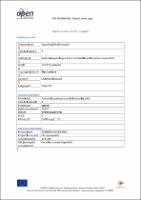Chapter 8 Signalling DNA Damage
| dc.contributor.author | Lopez-Contreras, Andres Joaquin | |
| dc.contributor.author | Fernandez-Capetillo, Oscar | |
| dc.contributor.author | Joaquin, Andres | |
| dc.contributor.author | Fernandez-Capetillo, Oscar | |
| dc.date.accessioned | 2019-10-04 14:39:07 | |
| dc.date.accessioned | 2020-04-01T14:06:36Z | |
| dc.date.accessioned | 2016-08-01 23:55 | |
| dc.date.accessioned | 2019-10-04 14:39:07 | |
| dc.date.accessioned | 2020-04-01T14:06:36Z | |
| dc.date.accessioned | 2016-12-31 23:55:55 | |
| dc.date.accessioned | 2019-10-04 14:39:07 | |
| dc.date.accessioned | 2020-04-01T14:06:36Z | |
| dc.date.available | 2020-04-01T14:06:36Z | |
| dc.date.issued | 2012 | |
| dc.identifier | 612634 | |
| dc.identifier | OCN: 1030821210 | en_US |
| dc.identifier.uri | http://library.oapen.org/handle/20.500.12657/32323 | |
| dc.description.abstract | During our lifetime, the genome is constantly being exposed to different types of damage caused either by exogenous sources (radiations and/or genotoxic compound) but also as byproducts of endogenous processes (reactive oxigen species during respiration, stalled forks during replication, eroded telomeres, etc). From a structural point of view, there are many types of DNA damage including single or double strand breaks, base modifications and losses or base-pair mismatches. The amount of lesions that we face is enormous with estimates suggesting that each of our 1013 cells has to deal with around 10.000 lesions per day [1]. While the majority of these events are properly resolved by specialized mechanisms, a deficient response to DNA damage, and particularly to DSB, harbors a serious threat to human health [2]. DSB can be formed [1] following an exposure to ionizing radiation (X- or γ-rays) or clastogenic drugs; [2] endogenously, during DNA replication, or [3], as a consequence of reactive oxygen species (ROS) generated during oxidative metabolism. In addition, programmed DSB are used as repair intermediates during V(D)J and Class-Switch recombination (CSR) in lymphocytes [3], or during meiotic recombination [4]. Because of this, immunodeficiency and/or sterility problems are frequently associated with DDR-related pathologies. | |
| dc.language | English | |
| dc.subject.classification | thema EDItEUR::P Mathematics and Science::PD Science: general issues | en_US |
| dc.subject.other | dna damage | |
| dc.subject.other | dna damage | |
| dc.subject.other | Apoptosis | |
| dc.subject.other | Ataxia telangiectasia and Rad3 related | |
| dc.subject.other | ATM serine/threonine kinase | |
| dc.subject.other | DNA repair | |
| dc.subject.other | DNA-PKcs | |
| dc.subject.other | Phosphorylation | |
| dc.subject.other | Protein | |
| dc.subject.other | Ubiquitin | |
| dc.title | Chapter 8 Signalling DNA Damage | |
| dc.type | chapter | |
| oapen.identifier.doi | 10.5772/50863 | |
| oapen.relation.isPublishedBy | 09f6769d-48ed-467d-b150-4cf2680656a1 | |
| oapen.relation.isPartOfBook | 3fcc457e-7b5b-42bf-8b8b-00f21d1da8d3 | |
| oapen.relation.isFundedBy | 7292b17b-f01a-4016-94d3-d7fb5ef9fb79 | |
| oapen.collection | European Research Council (ERC) | |
| oapen.chapternumber | 1 | |
| oapen.grant.number | 210520 | |
| oapen.grant.acronym | CHROMOREPAIR | |
| oapen.grant.program | FP7 | |
| oapen.remark.public | Relevant Wikipedia pages: Apoptosis - https://en.wikipedia.org/wiki/Apoptosis; Ataxia telangiectasia and Rad3 related - https://en.wikipedia.org/wiki/Ataxia_telangiectasia_and_Rad3_related; ATM serine/threonine kinase - https://en.wikipedia.org/wiki/ATM_serine/threonine_kinase; DNA - https://en.wikipedia.org/wiki/DNA; DNA repair - https://en.wikipedia.org/wiki/DNA_repair; DNA-PKcs - https://en.wikipedia.org/wiki/DNA-PKcs; Phosphorylation - https://en.wikipedia.org/wiki/Phosphorylation; Protein - https://en.wikipedia.org/wiki/Protein; Ubiquitin - https://en.wikipedia.org/wiki/Ubiquitin | |
| oapen.identifier.ocn | 1030821210 |

